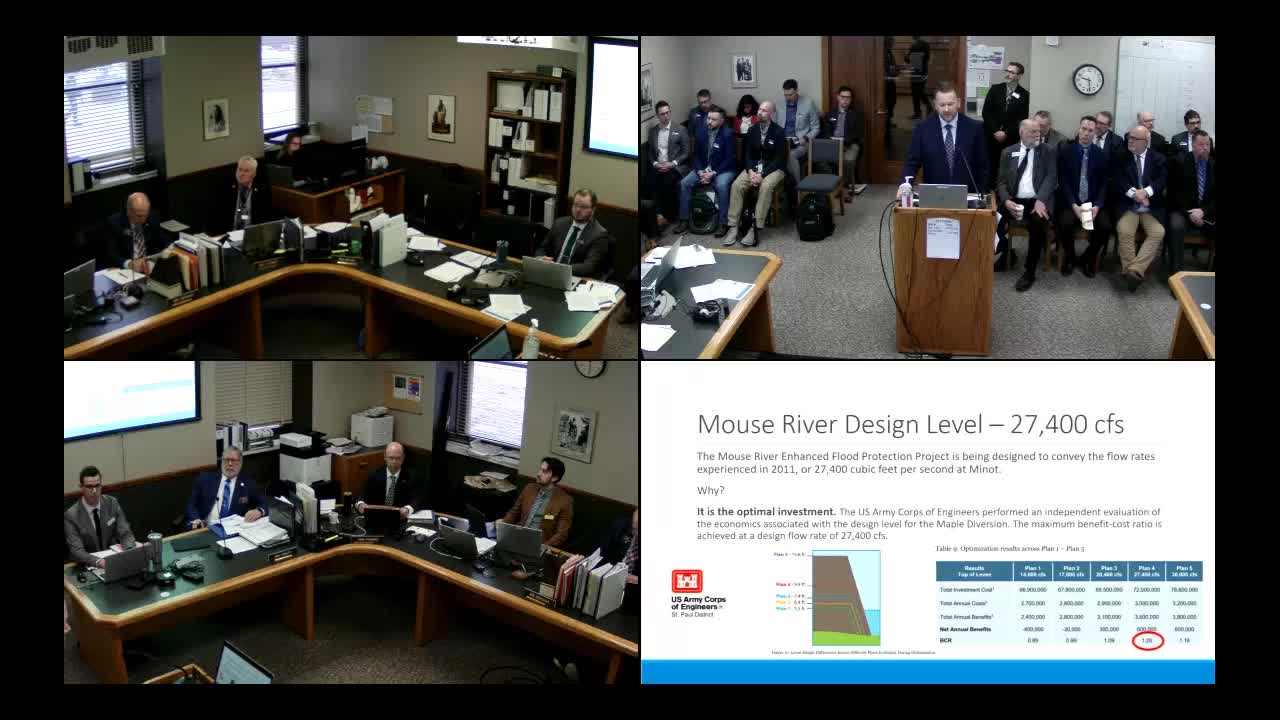Joint Board reviews flood risk management strategies for Minot and rural areas
March 11, 2025 | Appropriations - Education and Environment Division, Senate, Legislative, North Dakota
This article was created by AI summarizing key points discussed. AI makes mistakes, so for full details and context, please refer to the video of the full meeting. Please report any errors so we can fix them. Report an error »

The Senate Appropriations - Education and Environment Division of the North Dakota State Legislature convened on March 11, 2025, to discuss critical flood management strategies and investments in the region. The meeting focused on the evaluation of flood risk management projects, particularly in relation to the Minot community and surrounding rural areas.
The session began with a presentation highlighting the findings of the Corps of Engineers regarding the optimal design flow rate for flood management. It was noted that a flow rate of 2,400 cubic feet per second (CFS) yielded the highest benefit-cost ratio of 1.2, based on an extensive evaluation of flow rates ranging from 14,000 CFS to 36,000 CFS. The discussion emphasized that scaling down the project to a lower capacity would not provide significant cost savings, as a proposed reduction to 10,000 CFS would only save approximately 6% while compromising project value.
The committee underscored the importance of a basin-wide approach to flood risk management, which includes four reservoirs upstream of Minot—three located in Canada and one in North Dakota. This international collaboration aims to enhance adaptive reservoir management, benefiting both urban and rural communities.
Concerns were raised regarding the definition of "rural" in the context of flood management investments. The original plans aimed to protect Minot and nearby rural communities, including Burlington, Velva, and Sawyer. The Joint Board has implemented programs to assist rural residents, including acquisition and relocation efforts for those at risk of flooding. A proposed mitigation program, estimated at $2 million, seeks to address the prolonged flooding experienced by rural residents due to reservoir operations.
The discussion also touched on the historical context of flood risk assessments, noting that the statistical models used to predict flood events are based on a century of data that may not accurately reflect future conditions. The meeting concluded with a reminder of the real impacts of the 2011 flood, reinforcing the need for robust flood management strategies.
Overall, the meeting highlighted the ongoing commitment to flood risk management in North Dakota, balancing the needs of urban and rural communities while preparing for potential changes in climate and hydrology. The committee expressed gratitude for past support and opened the floor for questions, though none were posed.
The session began with a presentation highlighting the findings of the Corps of Engineers regarding the optimal design flow rate for flood management. It was noted that a flow rate of 2,400 cubic feet per second (CFS) yielded the highest benefit-cost ratio of 1.2, based on an extensive evaluation of flow rates ranging from 14,000 CFS to 36,000 CFS. The discussion emphasized that scaling down the project to a lower capacity would not provide significant cost savings, as a proposed reduction to 10,000 CFS would only save approximately 6% while compromising project value.
The committee underscored the importance of a basin-wide approach to flood risk management, which includes four reservoirs upstream of Minot—three located in Canada and one in North Dakota. This international collaboration aims to enhance adaptive reservoir management, benefiting both urban and rural communities.
Concerns were raised regarding the definition of "rural" in the context of flood management investments. The original plans aimed to protect Minot and nearby rural communities, including Burlington, Velva, and Sawyer. The Joint Board has implemented programs to assist rural residents, including acquisition and relocation efforts for those at risk of flooding. A proposed mitigation program, estimated at $2 million, seeks to address the prolonged flooding experienced by rural residents due to reservoir operations.
The discussion also touched on the historical context of flood risk assessments, noting that the statistical models used to predict flood events are based on a century of data that may not accurately reflect future conditions. The meeting concluded with a reminder of the real impacts of the 2011 flood, reinforcing the need for robust flood management strategies.
Overall, the meeting highlighted the ongoing commitment to flood risk management in North Dakota, balancing the needs of urban and rural communities while preparing for potential changes in climate and hydrology. The committee expressed gratitude for past support and opened the floor for questions, though none were posed.
View full meeting
This article is based on a recent meeting—watch the full video and explore the complete transcript for deeper insights into the discussion.
View full meeting
